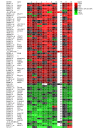Insight in modulation of inflammation in response to diclofenac intervention: a human intervention study
- PMID: 20178593
- PMCID: PMC2837611
- DOI: 10.1186/1755-8794-3-5
Insight in modulation of inflammation in response to diclofenac intervention: a human intervention study
Abstract
Background: Chronic systemic low-grade inflammation in obese subjects is associated with health complications including cardiovascular diseases, insulin resistance and diabetes. Reducing inflammatory responses may reduce these risks. However, available markers of inflammatory status inadequately describe the complexity of metabolic responses to mild anti-inflammatory therapy.
Methods: To address this limitation, we used an integrative omics approach to characterize modulation of inflammation in overweight men during an intervention with the non-steroidal anti-inflammatory drug diclofenac. Measured parameters included 80 plasma proteins, >300 plasma metabolites (lipids, free fatty acids, oxylipids and polar compounds) and an array of peripheral blood mononuclear cells (PBMC) gene expression products. These measures were submitted to multivariate and correlation analysis and were used for construction of biological response networks.
Results: A panel of genes, proteins and metabolites, including PGE2 and TNF-alpha, were identified that describe a diclofenac-response network (68 genes in PBMC, 1 plasma protein and 4 plasma metabolites). Novel candidate markers of inflammatory modulation included PBMC expression of annexin A1 and caspase 8, and the arachidonic acid metabolite 5,6-DHET.
Conclusion: In this study the integrated analysis of a wide range of parameters allowed the development of a network of markers responding to inflammatory modulation, thereby providing insight into the complex process of inflammation and ways to assess changes in inflammatory status associated with obesity.
Trial registration: The study is registered as NCT00221052 in clinicaltrials.gov database.
Figures




Similar articles
-
Visfatin, low-grade inflammation and body mass index (BMI).Clin Endocrinol (Oxf). 2008 Oct;69(4):568-74. doi: 10.1111/j.1365-2265.2008.03205.x. Epub 2008 Jan 31. Clin Endocrinol (Oxf). 2008. PMID: 18248642
-
Effects of photobiomodulation therapy and topical non-steroidal anti-inflammatory drug on skeletal muscle injury induced by contusion in rats-part 2: biochemical aspects.Lasers Med Sci. 2017 Nov;32(8):1879-1887. doi: 10.1007/s10103-017-2299-2. Epub 2017 Aug 9. Lasers Med Sci. 2017. PMID: 28795275
-
Distinctive modulation of inflammatory and metabolic parameters in relation to zinc nutritional status in adult overweight/obese subjects.J Nutr Biochem. 2010 May;21(5):432-7. doi: 10.1016/j.jnutbio.2009.02.001. Epub 2009 May 7. J Nutr Biochem. 2010. PMID: 19427184
-
Regulation of inflammation-related genes in human adipose tissue.J Intern Med. 2007 Oct;262(4):422-30. doi: 10.1111/j.1365-2796.2007.01851.x. J Intern Med. 2007. PMID: 17875178 Review.
-
Fatty acid-gene interactions, adipokines and obesity.Eur J Clin Nutr. 2011 Mar;65(3):285-97. doi: 10.1038/ejcn.2010.277. Epub 2011 Jan 12. Eur J Clin Nutr. 2011. PMID: 21224869 Review.
Cited by
-
Exploratory plasma proteomic analysis in a randomized crossover trial of aspirin among healthy men and women.PLoS One. 2017 May 25;12(5):e0178444. doi: 10.1371/journal.pone.0178444. eCollection 2017. PLoS One. 2017. PMID: 28542447 Free PMC article. Clinical Trial.
-
The Immune Response of Cancer Cells in Breast and Gynecologic Neoplasms.Int J Mol Sci. 2024 Jun 5;25(11):6206. doi: 10.3390/ijms25116206. Int J Mol Sci. 2024. PMID: 38892394 Free PMC article. Review.
-
The interplay of inflammation and placenta in maternal diabetes: insights into Hofbauer cell expression patterns.Front Immunol. 2024 Mar 25;15:1386528. doi: 10.3389/fimmu.2024.1386528. eCollection 2024. Front Immunol. 2024. PMID: 38590527 Free PMC article.
-
The Functionality of UDP-Glucuronosyltransferase Genetic Variants and their Association with Drug Responses and Human Diseases.J Pers Med. 2021 Jun 14;11(6):554. doi: 10.3390/jpm11060554. J Pers Med. 2021. PMID: 34198586 Free PMC article. Review.
-
Annexin A1 in blood mononuclear cells from patients with coronary artery disease: Its association with inflammatory status and glucocorticoid sensitivity.PLoS One. 2017 Mar 22;12(3):e0174177. doi: 10.1371/journal.pone.0174177. eCollection 2017. PLoS One. 2017. PMID: 28329022 Free PMC article.
References
-
- Saadeddin SM, Habbab MA, Ferns GA. Markers of inflammation and coronary artery disease. Medical Science Monitor. 2002;8(1) - PubMed
-
- Spranger J, Kroke A, Möhlig M, Hoffmann K, Bergmann MM, Ristow M, Boeing H, Pfeiffer AFH. Inflammatory cytokines and the risk to develop type 2 diabetes: Results of the prospective population-based European Prospective Investigation into Cancer and Nutrition (EPIC)-Potsdam study. Diabetes. 2003;52:812–817. doi: 10.2337/diabetes.52.3.812. - DOI - PubMed
Publication types
MeSH terms
Substances
Associated data
LinkOut - more resources
Full Text Sources
Medical

